|
In connection with the anticipated opening of a new Essex County Jail in Lewis, N. Y., during the summer of 2007, the New York Correction History Society (NYCHS) created this "virtual tour" of pre-computer record keeping at the county's old jail in Elizabethtown.
This part of the tour examines seven letters found together in the expenses or purchases audit book (left) maintained by a three-member Purchasing Committee of the Essex County Board of Supervisors tracking the operating costs for the county jails from Feb. 1, 1904 through April 24, 1931.
The operating expenses ledger is one of three jail ledgers made available to NYCHS by Major Richard Cutting, Essex County Jail Administrator since 1977.
In this particular Essex County jails' ledger book were seven letters seemingly tucked away neatly between numbered pages 254 (no entries on the page) and 255 (Jan. 3rd, 1920 entries).
Four of the letters were from R. C. Bunge, chief engineer of the Stewart Iron Works Co., Cincinnati, The letters, addressed to Essex County Sheriff John P. Crowley, were dated Oct. 16, 1943; Feb. 12, 1944; March 2, 1944; and May 16, 1944, the last letter referring to a lack of reply to the previous letter (March 2nd). The letterheads proudly proclaimed Stewart Iron Works Co. as "Jail and Prison Builders" (see example below right). 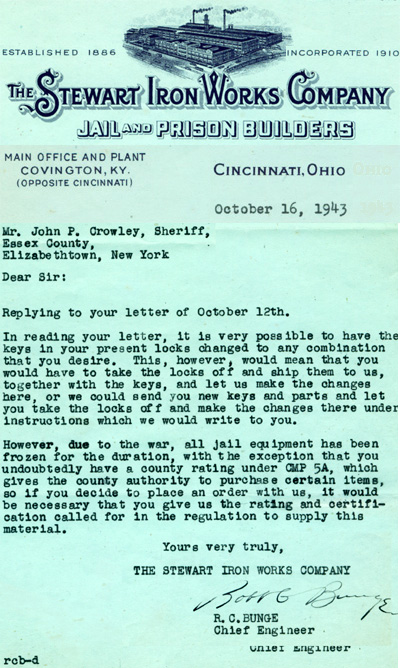 Click above 400-point wide composite image for a 550-point wide version, as per "Expand Images" box instructions above. Use back button to return to this page. Click above 400-point wide composite image for a 550-point wide version, as per "Expand Images" box instructions above. Use back button to return to this page. |
It is interesting to note that the Stewart Iron Works response of Oct. 16, 1943 (image right) cited WWII restrictions on jail equipment. Even the light weight greenish-blue stock on which all four letters were typed reflected WWII home front restrictions on various paper products.
Sheriff Crowley's side of the correspondence was not among the letters found between the two ledger pages.
Making discovery of the 1943/1944 letters particularly interesting is the fact that the ledger's entry pages end in the May 5th, 1931 audit of "April Bills" on numbered Page 433.
What circumstances could have attended anyone leaving in that audit book those four letters written more than a dozen years after the last entries in the ledger? The letters clearly reflect an inquiry by Sheriff Crowley to Stewart Iron Works about changing keys and tumbler setups for existing jail locks. An examination by the NYCHS webmaster in doing this presentation found no entries for keys, locks, locksmiths or Stewart Iron Works on numbered Pages 254 and 255, nor among the several pages immediately before them, nor those pages immediately after them.
But the three other letters under the four Stewart Iron Works letters between the two ledger pages provide a slender peg on which to hang at least a theory to explain all seven being there together.
The three letters -- dated Feb. 15, 1949 (image left); May 17, 1949, and Oct. 6, 1949 and all addressed to Sheriff Crowley -- report the findings of inspections of the county jail in Elizabethtown by the "current grand jury." Each of the three letters is signed by a different grand jury foreman. Each is laudatory of the jail's appearance and operation.
That those three 1949 grand jury inspection letters were tucked in the ledger together with the four 1943/1944 letters about changing jail locks suggests a 1949 time element for Sheriff Crowley or his staffer going to the 1904-1931 ledger.
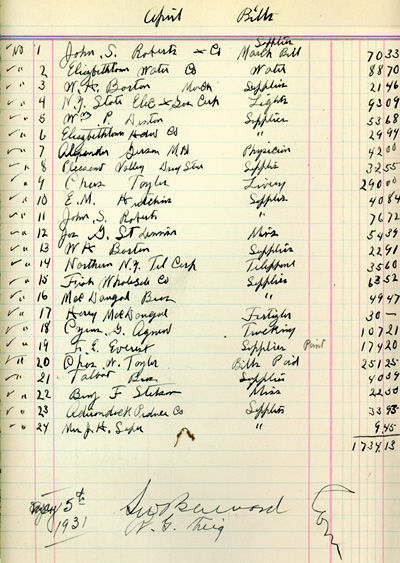 Above: Entries of May 5th, 1931, on last page of operating expenses audit book, numbered Page 433. Click image for full 550-point wide version, as per "Expand Images" box instructions further up this web page. Use back button to return to this page. Above: Entries of May 5th, 1931, on last page of operating expenses audit book, numbered Page 433. Click image for full 550-point wide version, as per "Expand Images" box instructions further up this web page. Use back button to return to this page. |
Could the sheriff's office have been researching in 1949 who or what firm might have installed or maintained the jail locks during any of the years covered by the ledger? If so, what in 1949 might have prompted undertaking that research?
Crowley first became sheriff in 1942 and held the post 15 years before retiring Dec. 31, 1957. So his making inquiries to Stewart Iron Works in 1943 about changing the jail locks would not have been a surprising move. Such a changeover of locks would have been a prudent precaution by a new administration taking charge of the jail.
But whether or not any lock changes resulted from that inquiry by Crowley cannot be deduced from the four 1943/1944 letters themselves. The fact that the fourth letter refers to a lack of response by the sheriff to company's previous letter doesn't necessarily mean that Crowley did not follow up later or in some other way. However, because of a violent event in late 1948 -- four years after the 1943/1944 lock-related correspondence and just three months before the first of the 1949 grand jury letters -- we do have reason to suspect that at least one faulty jail door mechanism had NOT been fixed.
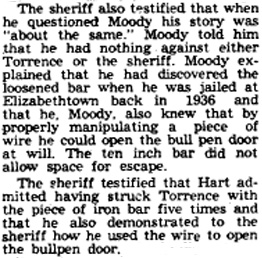 Above from The Essex County Republican of Dec. 3, 1948 relates to the jail's faulty bullpen door. The account was found using the Northern New York Historical Newspapers web site provided by the Northern New York Library Network. Click the image to access that site. Above from The Essex County Republican of Dec. 3, 1948 relates to the jail's faulty bullpen door. The account was found using the Northern New York Historical Newspapers web site provided by the Northern New York Library Network. Click the image to access that site. |
According to The Essex County Republican of Dec. 3, 1948 (image left) and other newspaper reports of the period, that faulty jail door mechanism figured in the escape by inmates William Moody and Edmund Hart from the Elizabethtown jail Nov. 15, 1948, during which they murdered jailor Earl Torrence.
Inmate Moody had spent time in the Elizabethtown jail a dozen years earlier and was aware from his 1936 detention there that the "bullpen" door could be opened by manipulating a wire a certain way. He found out during his 1948 stay that the old bullpen mechanism could still be manipulated open with a wire. That knowledge was put to use by Moody and Hart in making their escape during which Torrence was bludgeoned to death.
Coming only a matter of months after the deadly escape, could the grand jury inspections of the jail have prompted Sheriff Crowley or someone under his direction to look through the old ledger to find, if possible, what firm or locksmith had been involved in the original installation or subsequent maintenance of the jail locks?
 Above is from The Essex County Republican of March 11, 1949. Click the image to access its full 500-wide version. Above is from The Essex County Republican of March 11, 1949. Click the image to access its full 500-wide version. |
Inmates Moody and Hart pleaded guilty to second degree murder and were sentence to 50 years-to-life in Clinton State Prison at Dannemora in March, 1949. Did the late 1948 jail escape and jailor killing and the subsequent related developments continuing into 1949 call to mind for Sheriff Crowley the 1943/1944 letters from Stewart Iron Works regarding jail lock mechanisms and key changes and prompt research in the ledger where those letters were found in the course of preparing this 2007 web presentation?
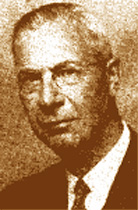 The above image of Sheriff John P. Crowley is based on his campaign ad photo in the Oct. 28, 1954 Adirondack Record-Elizabethtown Post. It was found using the Northern New York Historical Newspapers web site provided by the Northern New York Library Network. Click the image to access that site. The above image of Sheriff John P. Crowley is based on his campaign ad photo in the Oct. 28, 1954 Adirondack Record-Elizabethtown Post. It was found using the Northern New York Historical Newspapers web site provided by the Northern New York Library Network. Click the image to access that site. |
Certainly possible, even arguably probable.Would the jail bullpen door receiving a lock and key changeover of the kind mentioned in 1943/44 letters have prevented the inmates' escape and the turnkey's murder in 1948?
Not necessarily, but arguably prossible.
A reading of coroner inquest testimony given Dec. 1st, 1948, by the sheriff and state police investigators indicates that the fault with the bullpen door apparently was not in a key-related locking mechanism. Rather the problem was with a bar or blade that was supposed to hold the door shut but that could be dislodged through manipulation with a stiff wire.
Whether a changing of the lock mechanisms would have involved checking other parts of the doors' operation and would thus have led to uncovering the vulnerability of the bar/blade to manipulation is uncertain. But it could quite conceivably have done so.
 The above image of Sheriff John P. Crowley's front page obituary in The Adirondack Record-Elizabethtown Post of Aug. 8, 1963. It was found using the Northern New York Historical Newspapers web site provided by the Northern New York Library Network. Click the image to access that site. The above image of Sheriff John P. Crowley's front page obituary in The Adirondack Record-Elizabethtown Post of Aug. 8, 1963. It was found using the Northern New York Historical Newspapers web site provided by the Northern New York Library Network. Click the image to access that site. |
Even if not a lock-and-key problem as such, the faulty bullpen door mechanism's involvement in the jail breakout could easily have prompted Sheriff Crowley to review past supplies and services related to locks and keys in general.
To suspect that such a search for lock-related entries was taking place when the seven letters -- four from 1943/44 and three from 1949 -- were placed in the 1904/1931 ledger may be speculative but not unreasonably so. Here's a possible scenario:
Perhaps both the 1943/1944 Stewart Iron Works correspondence and the 1949 grand jury letters were in hand when Crowley or his staffer began the ledger research.
Then something more pressing may have interrupted the ledger entries search.
At that juncture the seven letters were placed together in the ledger for temporary safekeeping and to mark the place in the book where the research had been interrupted.
Later perhaps the ledger was put away with the intent to resume the search eventually, but instead the research was eventually forgotten entirely, along with the seven letters left still sandwiched between numbered Pages 254 and 255, where they were found by the NYCHS webmaster in the preparing this presentation
How plausible a scenario?
Have a better one?
If so, let us hear it. Perhaps we'll add to this page.
A STATE PRISON CO’s REMEMBRANCE OF A COUNTY JAILER
Meanwhile, what we will add here is the factual story, not speculative theory, on how a state correction officer played a key role in having slain Essex County jailor Earl Torrence's sacrifice memorialized. Joe Stickney never personally knew his great uncle Earl Torrence. Joe was born in May 1951, about two and a half years after Earl died in November 1948. Nevertheless, a significant part of Joe’s life involves remembrance of Earl.
Believed the only Essex County jailer ever killed by inmate violence, Torrence was slain during the jailbreak more than a half century ago in Elizabethtown, N.Y. NYS Correction Officer Joe Stickney, assigned to the Ogdensburg Correctional Facility most of his 23 years with DOCS, lives about six miles southeast of the prison in a St. Lawrence County ex-farmhouse. His home -- across the road from the Oswegatchie River in the heavily but not exclusively Amish populated community of Heuvelton -- is filled with furniture from Earl Torrence’s own ex-farmhouse in Bloomingdale, Essex County, about 200 miles away.
The chairs, tables, and chests had passed from one family branch to another, one generation to another, until their current residence. Likewise stories about his great uncle also were passed around at family gatherings down through the decades.
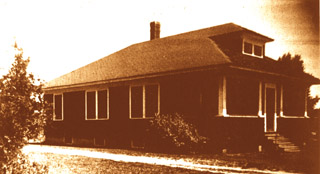
Above is image of Earl Torrence's former residence in Bloomingdale. Below is image of slain jailor from 1948 newspaper front page story reporting his murder by escaping inmates.
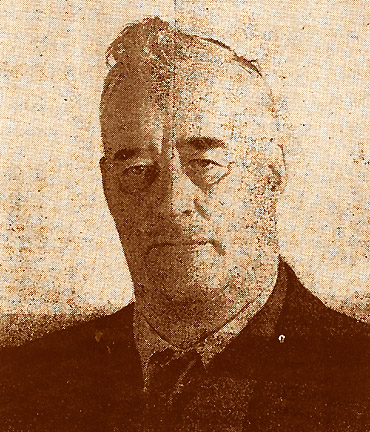 |
"When a family has had in it a sheriff’s deputy killed by escaping prisoners who were eventually recaptured after massive manhunts, the stories about him get told and retold," Joe recalls. "While I was growing up, those tales of the killing, escape and recapture became as much a part of my life as if I had been there at the time.
"Later, when I had a house of my own, his furniture came my way, those pieces that weren’t sold off as part of another deceased family member’s estate. So the chair I sit in to watch TV, the table I eat at, the chest where I keep some clothes – all these help remind me of the great uncle whom I never met but whom I know from family lore."
Then there’s a Twilight Zone kind of connection that Joe didn’t realize until after he had begun seriously researching Earl’s death.
"My uncle was killed ‘on the job’ at the jail Nov. 15. I went ‘on the job’ with the state prisons Nov. 15 – exactly 34 years later to the day," Joe notes. "But I didn’t know that when I joined."
While ‘on the job’ one day in 1997, Joe was recounting to fellow officers some family stories about his deputy sheriff great uncle, when Superintendent John O’Keefe chanced to overhear a bit of the conversation.
The superintendent asked Joe if he knew about the memorial wall in Washington, D.C., where names of law enforcement officers killed in the line of duty can be inscribed. Joe said he had never heard of it but wanted to learn more.
O’Keefe explained that the National Law Enforcement Memorial was dedicated in 1989, that additional names are unveiled annually at May 15 Peace Officers Memorial Day ceremonies, and that one of his own relatives from Buffalo -- an uncle -- is memorialized there. Joe asked how to go about getting Earl’s name added to the wall.
Within days, the superintendent had for CO Stickney a package of forms and instruction materials from the National Law Enforcement Memorial Fund (NLEMF).
The requirements set by NLEMF for considering officers’ names submitted for inscription on the wall can be summed up, unofficially, in two words: documentation, endorsement.
Understandably, CO Stickney thought the Essex County Sheriff’s Department that runs the county jail would be the source for both.
But unfortunately one or more of Sheriff Henry Hommes’ predecessor administrations had failed to pass along any records or institutional memory concerning a slain-in-the-line-of-duty jailer named Earl Torrence. Nevertheless, the sheriff and his staff were interested and supportive. They encouraged Joe in his documentation quest, suggested possible research avenues to pursue, and indicated willingness to endorse the application to NLEMF once some relevant record was found.
CO Stickney's research was hampered by his own lack of any of Earl's personal papers. Joe had Torrence's furniture. Another relative had Earl's badge from when Torrence had been a constable in Bloomingdale, Essex County. Various kin had album photos that included Earl. But no one had any of his personal records, certificates and the like.
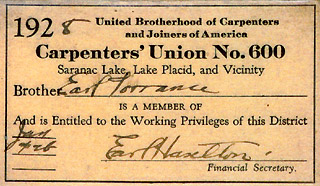 Earl Torrence's 1928 carpenters' union card. Earl Torrence's 1928 carpenters' union card. |
Also hampering research was the vagueness of the few surviving relatives' memories as to when the fatal jailbreak had happened.They placed it "in the '40s." Joe was told that it had occurred long before he was born. So he spent many, many hours at the library looking for the jailbreak story through back issues of local newspapers, beginning with those from the year 1940. By the time he had gone through the 1946 newspapers without success, Joe decided to try another approach. 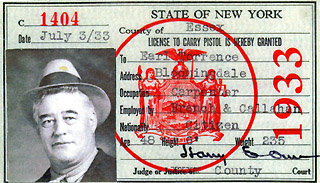 Earl Torrence's 1933 pistol permit. Earl Torrence's 1933 pistol permit. |
He visited the Bloomingdale cemetery where Earl's body had been buried -- about 86 mile drive from the Stickney homestead near Ogdensburg. From the gravestone he obtained the date of death: Nov. 15, 1948.
Armed with that information, CO Stickney returned to his newspaper research and soon found numerous stories about the inmates bludgeoning of Earl, the escape, the manhunt and the recapture. Since the stories showed that state troopers had played significant roles in the hunt, capture and follow-up investigation, Joe contacted their headquarters. He also was in contact with local historian Mary MacKenzie, since deceased, and with Victoria Hristovski, then an Adirondack Daily Enterprise reporter but later spokesperson for the Adirondack Park Agency. Her newspaper article about his quest generated yet more contacts.
 Essex County Jail Administrator Richard Cutting at the May 15, 2000, National Peace Officers Day ceremonies adding names to the National Law Enforcement Memorial wall, including slain Elizabethtown jailor Earl Torrence's. Essex County Jail Administrator Richard Cutting at the May 15, 2000, National Peace Officers Day ceremonies adding names to the National Law Enforcement Memorial wall, including slain Elizabethtown jailor Earl Torrence's. |
As a result of all the various contacts, Stickney slowly assembled a sizable package of documentation, more than ample to warrant Sheriff Hommes' endorsing the application to inscribe Torrence's name on the D.C. memorial wall.Earl's was among those newly-added names unveiled May 15, 2000, at National Peace Officers Day ceremonies. Attending in particular recognition of Deputy Torrence, besides CO Stickney and his family, were representatives of the Essex County Sheriff's Department.
Additionally, the Essex County Jail mounted a display in its lobby to retell the story of Deputy Torrence's service and sacrifice. A similar is display is planned for the lobby of the new Essex County jail under construction in Lewis and scheduled for completion in the summer of 2007, according to jail administrator, Major Richard Cutting. CO Stickney is working with Essex jail authorities on this new remembrance of the great uncle whom he never met but who has been a significant part of his life nonetheless.
 One of Earl Torrence's tickets from 1934 when he was a constable. He would pre-sign them, then fill in details when he found a violation. Interestingly, he seems to have signed his first name as Earle." One of Earl Torrence's tickets from 1934 when he was a constable. He would pre-sign them, then fill in details when he found a violation. Interestingly, he seems to have signed his first name as Earle." |
Hopefully that new lobby display memoralizing jailor Earl Torrence will make appropriate mention of his wife, Kathleen Marie, - whose faith in him helped him persevere despite various employment setbacks in life,
- whose worry about his not responding to her calls led to the terrible discovery of his brutal murder, and
- whose letter to authorities played a significant role in sparing his killers' lives.
The ironic contrast of the Nov. 15, 1948 deadly encounter -- the gentle pair and the violent pair, the caring older couple and the couple of uncaring young criminals -- seems underscored by the date that the latter two were indicted for fatally bludgeoning Earl: Feb. 14, 1949. That indictment date would have been another of Kathleen and Earl's dozen of St. Valentine's Day together.
On a day when Kathleen ordinarily might otherwise have been thinking what personal note to inscribe on her Valentine card to Earl, the recently widowed Mrs. Torrence may well have begun weighing what to write to the prosecutor concerning the mandatory death penalty carried by the 1st Degree Murder indictment counts returned against the two recaptured prisoners
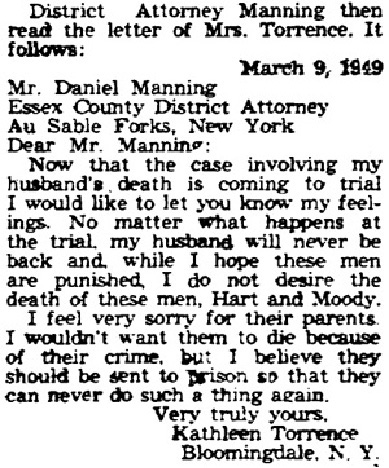 Text of Kathleen Torrence's letter to DA Manning. The account was found using the Northern New York Historical Newspapers web site provided by the Northern New York Library Network. Text of Kathleen Torrence's letter to DA Manning. The account was found using the Northern New York Historical Newspapers web site provided by the Northern New York Library Network. |
The words in her letter to Essex County DA Daniel T. Manning may interest people who argue the issues that still swirl around about capital punishment three decades after the U.S. Supreme Court struck down state mandatory death sentence statutes.
Her words (image left) appeared as part of the Essex County Republican front page main story of Friday, March 11, 1949, about the sentencing of Hart and Moody.
A quarter century before that ruling by the nation's high court, this 56-year-old upstate New Yorker publicly declared she did not desire to have the death penalty for the two defendants. Her letter to that effect was received March 10th and read that same day by DA Manning in open court. He did so in connection with his consenting to the two pleading guilty to 2nd Degree Murder charges and their being sentenced by State Supreme Court Justice Willard L. Best to 50-years-to-life imprisonment each.
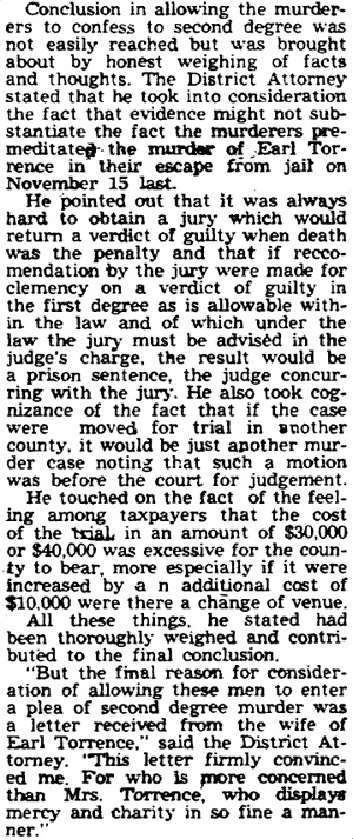 Story of Kathleen Torrence's letter to DA Manning. It was found using the Northern New York Historical Newspapers web site provided by the Northern New York Library Network. Story of Kathleen Torrence's letter to DA Manning. It was found using the Northern New York Historical Newspapers web site provided by the Northern New York Library Network. |
DA Manning, in his reported court remarks (image right) before reading Mrs. Torrence’s letter, pictured her words as providing him with a major persuasive push finally moving him to adopt the position toward which he was already leaning.The Ticonderoga Sentinel, in its March 17, 1949 editorial that supported DA Manning's decision to plead the case down to the lower murder count, placed at the top of its list of reasons favoring the arrangement the widow's own wishes as expressed in her letter to the prosecutor.
But was it a situation where the county authorities wanted to dispose of the matter without the expense of a trial and were willing to offer life sentences in exchange for guilty pleas, provided that the victim’s widow didn’t insist on seeking death sentences? Or was it a situation where, the widow having declared herself against seeking the death sentence, the authorities decide to accede to her wishes rather than oppose them with a 1st Degree murder trial costly to the county?
Kathleen was known as a woman of deep religious faith, an aspect that undoubtedly has to be weighed in order to come to any understanding of her not seeking the ultimate retribution against Earl's killers.
Also to be considered is the heart-wrenching, if ironic fact that William Moody's mother, Ida Scofield Moody of Saranack lake, was one of Kathleen's closest friends. So when Mrs. Torrence's letter concerning what course to take regarding Moody and Hart declared "I feel very sorry for their parents," Kathleen was not referring to "their parents" as remote abstractions.
 Stories of the Earl Torrence funeral. Above from Nov. 17, 1948 Adirondack Daily Enterprise. The accounts were found using the Northern New York Historical Newspapers web site provided by the Northern New York Library Network. Stories of the Earl Torrence funeral. Above from Nov. 17, 1948 Adirondack Daily Enterprise. The accounts were found using the Northern New York Historical Newspapers web site provided by the Northern New York Library Network.
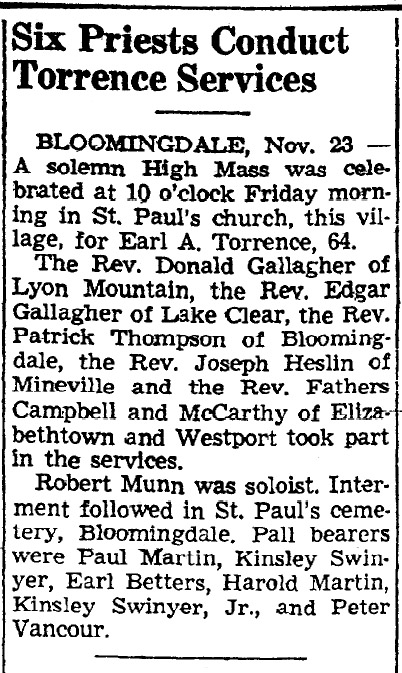 |
One additional fact may prove an interesting line for further research and inquiry: there were Moodys in Earl Torrence's family tree: his own mother's maiden name was Moody.
Clearly Kathleen played a pivotal role in the disposition of the case as she had in the discovery of the crime. . . . .
Earl’s last day with her, Nov. 15, 1948, began before 7 a.m. as he prepared to go work at the county jail and she began to prepare breakfast. She had broken her arm in a fall some days earlier, so doing even routine tasks took longer. About 7:15 a.m. Earl left the residence – known as the Perry House -- on the county courthouse and jail grounds to check situation at the lockup. Only about 50 feet separated the Perry House from the jail. He returned home about 45 minutes later for breakfast with her. He returned to the jail afterward but joined her for lunch at home. Likewise, he joined her there for supper about 5:45 p.m. and returned to jail about 6:20 p.m.
"It was usual for me to visit my husband at the jail while he was working nights," Kathleen explained in her sworn Nov. 21st, 1948 deposition submitted to the county coroner for the inquest into Earl's death, a deposition notarized by Anne E. Crowley. one of the sheriff's three daughters.
"I left the house at 8:30 p.m. and went to the jail where I visited with my husband until 9 p.m. when I left accompanied part way by my husband as he wanted to see that I arrived home alright. "After turning on the light in the house, I called to Earl and told him that everything was alright . . . [Due to the broken arm] "I expected Earl back home [later] as he had to help me undress [for bed]. "When he had not returned by 10 p.m.. I looked over and saw that the lights on the lower floor were still on. I walked over to the jail, and going outside of Earl's bedroom, I called to him but received no answer. "I walked around the building and called several times but received no answer. I looked through the outside cell doors and saw that the cell door leading into the jail proper was partly open. . . . "I then returned to the jail with Mr. Crowley and when we arrived at the inside cell door, I looked in and saw blood on the floor . . . . "I was downstairs with Mrs. Crowley and Ann Crowley while the Sheriff and [Undersheriff] George [Young] went upstairs. When the Sheriff came back down the stairs he told that two men had escaped. I asked him about Earl and if he was dead. The Sheriff replied that he thought he was. I do not recall much of anything else that happened that night . . . ."
Joe Stickney hasn't been able to pin down exactly how long Kathleen and Earl were married.
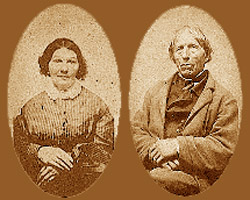 Thomas Norman and his wife, Ann Harker Norman. Thomas Norman and his wife, Ann Harker Norman. |
The NYCHS webmaster's researches using the Northern New York Historical Newspapers web site found small social squibs going as far back as 1915 reporting "Mrs. Kathleen Torrence" visiting her father, A. L. Norman and other relatives on Norman Ridge. So Kathleen and Earl had been married at least 33 years at the time of the jailor's death.
Her family's ancestral roots trace back to Yorkshire, England. Thomas Norman and his wife, Ann Harker Norman, came to North America around 1829, first to Canada and then to Peru, N.Y. and then Lewis, When their son John, who came with them from Britain at age 5, was 26 years old, he bought land near Bloomingdale, N.Y., cleared the forest on it and grew potatoes that he sold to a starch factory.
In 1855, John married Hannah Allen Fletcher. They had five children who in the fullness of time married and had children of their own. Most all of the Normans stayed and farmed the land. Thus in due course, the area became known as Norman Ridge.
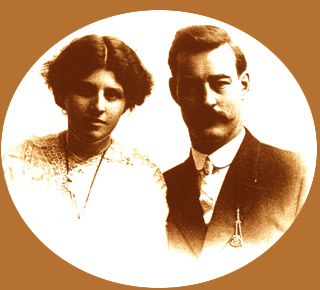 Earl Anson Torrence and his wife, Kathleen Norman Torrence. Earl Anson Torrence and his wife, Kathleen Norman Torrence. |
One of John and Hannah's sons was A. L. Norman, born about when the Civil War began.His name in the local newspapers usually appeared as "A. L. Norman," sometimes "Abraham L. Norman" or even "Abram Norman," but his full name was actually Abraham Lincoln Norman. His parents apparently gave him that name in a moment of patriotic zeal as a show of support for the 16th President and his efforts to preserve the Union.
Surrounded by most of his family, Abraham Lincoln Norman died in 1921 in the Norman Ridge homestead where he had been born some 60 years earlier, on land he farmed all his boyhood and adult life. According to his obituary, his daughter, Kathleen Torrence was herself so ill at the time that she was unable to be with her father and family at his end or attend his funeral.
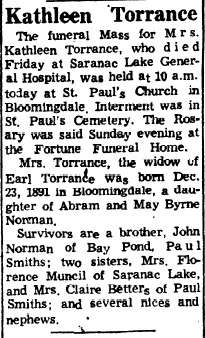 Obituary for Kathleen Torrence, widow of Earl Torrence, the slain jailor. Ignore the spelling variation. The obit was found in the Sept. 11, 1967 Adirondack Daily Enterprise using the Northern New York Historical Newspapers web site provided by the Northern New York Library Network. Obituary for Kathleen Torrence, widow of Earl Torrence, the slain jailor. Ignore the spelling variation. The obit was found in the Sept. 11, 1967 Adirondack Daily Enterprise using the Northern New York Historical Newspapers web site provided by the Northern New York Library Network. |
Tracking Earl Torrence's ancestrial roots is complicated by the spelling variations his family name generates, some with a single "r" as in "Torence" and some with an "a" instead of an "e" as in"Torrance." "Fred A. Torrance" was a widely-known figure in Essex County during the first half of the 20th Century, holding various high-profile posts in local government and generating literally hounds of newspaper stories. Even so, his name was frequently spelled "Torrence" in several of those stories.
Likewise Earl Torrence's name itself was often spelled "Torrance" in newspapers stories. An excellent example of that is the obituary for his widow. It spelled the Torrence name with an "a" both in the headline and in the main text.
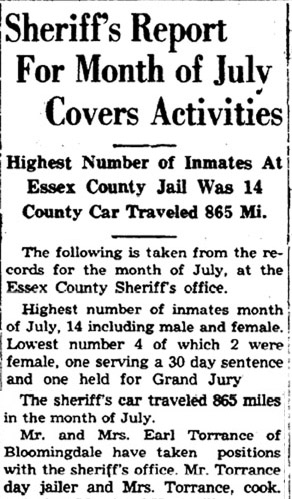 The Aug. 17, 1945, issue of The Adirondack Record included an article (shown in part above and below left) that, among other things, listed both Torrences as employed at the jail, at least at that time. The Aug. 17, 1945, issue of The Adirondack Record included an article (shown in part above and below left) that, among other things, listed both Torrences as employed at the jail, at least at that time. |
The Torrances and Torrences seemed to be concentrated in the Jay region, but a few were scattered thoughout the county. Different genealogists attribute the family line to different places: some to Scotland, others to Ireland.
Earl's middle name was "Anson" but where that came from is unknown now. His father's first name was "Henry" but the name of either pair of grandparents is not known. Earl's mother's maiden name was "Anne Moody" but from which Moody family in the county is not known.
In researching the Torrences, using the Northern New York Historical Newspapers archives, the NYCHS came across an interesting story (image right) establishing the fact that both Earl and his wife Kathleen were employed by the Essex County Sheriff's Office. The article, appearing in the Aug. 17, 1945, issue of The Adirondack Record also contain many details about the sheriff office and jail operations more than 60 years ago. Here's the text under the multi-deck headline:
"Sheriff's Report For Month of July Covers Activities: Highest Number of Inmates At Essex County Jail Was 14; County Car Traveled 865 Mi.
"The following is taken from the records for the month of July, at the
Essex County Sheriff's office.
"Highest number of inmates month of July, 14 including male and female.
"Lowest number 4, of which 2 were female, one serving a 30 day sentence and one held for Grand Jury
"The male inmates were about evenly divided, as to those sentenced and those
held for Grand Jury.
"It is very noticeable at the present time the number of male inmates who are able to
obtain bail due to the fact that employers are in need of their services.
Females are not so fortunate.
"Eight complaints were investigated and the outcome varied. Those matters are confidential.
"Fifteen civil papers were served, of which 8 were in divorce proceedings coming from Hawaii and different parts of the U. S.
"Four [civil] executions and 3 garnishee executions were received and filed.
"There has been a decided decline in the number of executions and garnishees for the past two months, which indicates that obligations created in recent years are being liquidated as a very small fraction of 1% remains unpaid.
"Three emergency messages were delivered to summer residents in the county at the request of other sheriff’s offices and two persons located when their address was unknown to relatives.
"Six persons were fingerprinted for revolver or pistol licenses.
"The sheriff’s car traveled 865 miles in the month of July.
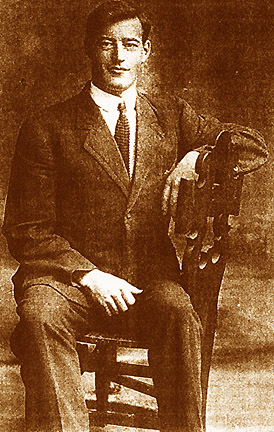 A young Earl Torrence. A young Earl Torrence. |
"Mr. and Mrs. Earl Torrance of Bloomingdale have taken positions with the sheriff’s office. Mr. Torrance,day jailer and Mrs. Torrance, cook.
"Arthur Martin of Keeseville has recently been appointed to the Deputy Sheriff staff.
"Visiting days for inmates are Monday, Wednesday and Friday, 2 to 4.
"Visitors who wish to go through the jail are welcome any day except Sunday between the hours of 9:30 and 11:30 and 1:30 to 4:30."
Using the Northern New York Historical Newspapers archives to research the "Moody" maiden name of Earl Torrence's mother, the NYCHS webmaster was unable to track it at all, much less establish whether or not there was any family connection to William Moody, his killer. But the historical newspaper research did find several stories providing background information on young Moody, and also Hart.
One of the earliest following the jail break appeared under the headline "Moody Seen As 'Brains,' Hart As 'Stooge' in 'Crushout'"in the Nov. 18th, 1948 issue of The Ticonderoga Sentinel, apparently written before the capture of Moody, which development was inserted as a front page bulletin:
 The above background on William Moody appeared in the Saranac Lake Adirondack Daily Enterprise as part of its Nov. 16, 1948, story on the jail breakout and the killing of turnkey Torrence. The account was found using the Northern New York Historical Newspapers web site provided by the Northern New York Library Network. The above background on William Moody appeared in the Saranac Lake Adirondack Daily Enterprise as part of its Nov. 16, 1948, story on the jail breakout and the killing of turnkey Torrence. The account was found using the Northern New York Historical Newspapers web site provided by the Northern New York Library Network. |
"William Moody, 31, of Saranac Lake, is believed to be the 'brains' and Edmund Hart, 21, of Keesevilie, the
'stooge' of the jailbreak engineered
by the pair Monday night which resulted in the brutal murder of Earl
Torrence, 64, deputy Essex County
jailer.
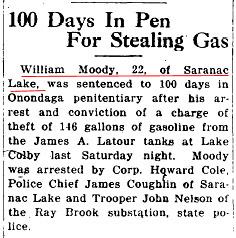 Story of an earlier Wm. Moody "prior" that appeared in the the March 23, 1929 Adirondack Record-Elizabethtown Post was found using the Northern New York Historical Newspapers web site provided by the Northern New York Library Network. /center> Story of an earlier Wm. Moody "prior" that appeared in the the March 23, 1929 Adirondack Record-Elizabethtown Post was found using the Northern New York Historical Newspapers web site provided by the Northern New York Library Network. /center> |
"Moody, a 'two-time loser,' served
6 1/2 years of a 1O-20 year sentence in
Clinton Prison at Dannemora, and was
released in Apr1l, 1946."He violated
his parole and was returned to Dannemora in March, 1947, and was
again discharged two months later
on a parole which wold not have expired until 1959. "He was under jurisdiction of Parole Officer Niel Bowers of Port Henry.
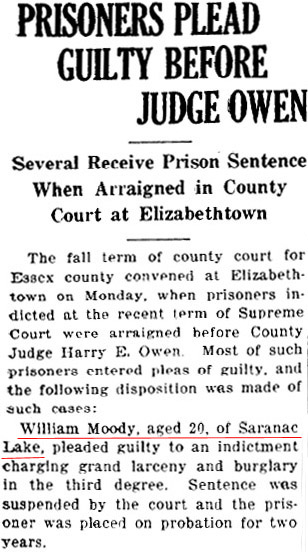 Story of another William Moody "prior." The account in the Oct. 15, 1936 Adirondack Record-Elizabethtown Post was found using the Northern New York Historical Newspapers web site provided by the Northern New York Library Network. Story of another William Moody "prior." The account in the Oct. 15, 1936 Adirondack Record-Elizabethtown Post was found using the Northern New York Historical Newspapers web site provided by the Northern New York Library Network. |
"Moody was being held in jail here
following his indictment a few weeks
ago for grand larceny third degree, and if convicted on this charge he
would have been committed to Dannemora for the balance of his probation period in addition to a sentence on the larceny count, which in
all might have totalled 15 years."The
latest accusation against him involved theft of an outboard motor from
Allard Oppenheimer of Saranac Lake.
"His unsavory, crime-sprinkled record also inc1udes petit larceny and
third degree burglary in Franklin
an4 Essex counties in 1936, for which
he served 59 days in Franklin County
jail, and in 1939 he was sentenced to
100 days in Onondaga Penitenitary
at Jamesvil1e for another violation.
 Story of Edmund Hart's "prior" before his jail escape in which turnkey Torrence was murdered. The account in the Sept. 10, 1948, Essex County Republican was found using the Northern NY Historical Newspapers web site. Another version also appeared in the Lake Placid News that date. Story of Edmund Hart's "prior" before his jail escape in which turnkey Torrence was murdered. The account in the Sept. 10, 1948, Essex County Republican was found using the Northern NY Historical Newspapers web site. Another version also appeared in the Lake Placid News that date. |
"Moody is considered an expert
woodsman, is fairly intelllgent, and
authorities are inclined to be1ieve he
laid the basic plans for the crashout
Monday."He is extremely tricky and
probably exerted his superior intelliegnce over Hart, who is considered
treacherous but who is of below average intelligence.
"Moody has a brother, Howard
Moody, also of Saranao Lake,
who.was sentenced to Clinton Prison last
June by Essex County Judge Sheldon F. Wickes of Ticondaroga for
wounding William Moody, a relative,
in a shooting affray in Saranac Lake.
"The fugative is separate4 from his
wife, and his chi1d who is being
cared for in a Jay nursing home. "He
reportedly hasn’t seen the infant since
his discharge from Dannemora and
apparentIy is oblivous of his welfare.
"Hart, while mean and vicious, and
described by Sheriff John P. Crow1ey as a 'troublemaker,' has no known
serious criminal record. "He is a
former resident of Keeseville and Ausable Forks, and his only admitted
clash with the law occurred in Connecticut, where he served two terms
in a reformatory following conviction
for a bicycle theft and misdemeunor
in Hartford. "He was released in Decemember 1947, and returned to his
Essex County haunts a few months ago.
"He was indicted by the recent Essex County grand jury on a charge of looting a North Lewis gas station
operated by. Barnes McGee Corp. and
similar establishment at Keeseville
owned by Alfred Spears. "The burglary netted him $15 in cash and cigars,
cigarettes and other merchandise
valued at $42. "He was allegedly
accompanied on these pilfering expeditions by a 17-year-o1d cousin.
"Moody [had] been held in the county
jail here since June 15. and Hart was committed on. Sept. 5.
 Story of disputed pill-swallowing in late February 1949 by inmate William Moody facing murder charges in the breakout that left jailor Earl Torrence dead. It was found in the Feb. 3, 1949 Ticonderoga Sentinel using the Northern New York Historical Newspapers web site provided by the Northern New York Library Network. Another version appeared in the Feb. 4, 1949 Essex County Republican. Story of disputed pill-swallowing in late February 1949 by inmate William Moody facing murder charges in the breakout that left jailor Earl Torrence dead. It was found in the Feb. 3, 1949 Ticonderoga Sentinel using the Northern New York Historical Newspapers web site provided by the Northern New York Library Network. Another version appeared in the Feb. 4, 1949 Essex County Republican. |
"Hart, surly and with a half-sneer on his face. was arraigned before
Judge Wickes at the opening of county court Monday."He entered a plea
of not guilty and demanded a jury trial
which had been scheduled for the present term.
"The older man, facing an almost certain sentence of 15 years, is believed to have persauded Hart to join in the jail break.
"While three other prisoners
in the cellblock where the murder was committed claim they were unaware of
the ecscape, one of them reportedly
hinted to police that Moody and Hart
planned to try and reach Washington
DC although the exact source
of this information was not disclosed
and police would divulge no details.
.
"At the time of their escape Moody is believed to have been wearing a gray suit and possibly a dark gray overcoat
which was missing from
a storeroom where prisoners’ clothes
were kept. "He is described by police
as 5 feet, 8 inches in height, is of medium build and weighs 130 pounds.
He has blue eyes, red hair and a ruddy complexion.
"In addition to the wallet containing
$17 in cash and a $35 check taken from Torrence's pocket, they also reportedly took two fountain pens from
Sheriff Crowley’s desk and it is also
possible they stole other articles of
clothtng from the storeroom in addition to the overcoat, officials said. . . .
William Moody's father was, like Earl Torrence, a carpenter by tade. Under the headline, "Charles Moody Dies, Retired Carpenter," his July 17, 1961 obituary listed three surviving sons, including "William of Dannemora." Charles S. Moody and his wife, Ida Scofield Moody, who also survived him, lived at 5 Crossfield Ave., Saranac lake. He had been born in Keene April 14, 1882.
"Besides Saranac Lake, the senior Moody left surviving relatives in Keene, Lake Clear, and Tupper Lake."
Perhaps one of the best summations of community sentiments of the Essex County region upon learning of the brutal murder of Essex County Jail turnkey Earl Torrence was penned by a prominent local attorney as a letter to the editor of a Saranac Lake, N.Y., newspaper and published by it Nov. 24, 1948, under the following headline:
"GUARDIANS OF THE LAW
"Editor,
Adirondack Daily Enterprise:
"I have been reading and watching
with more than a professional
interest about the escape and capture
of William Moody 32, and
Edmund Hart 21, now safely held
in custody at Elizabethtown, N. Y,,
for the alleged murder of Earl
Torrance, late of Bloomingdale, N. Y., on November 15th, 1948.
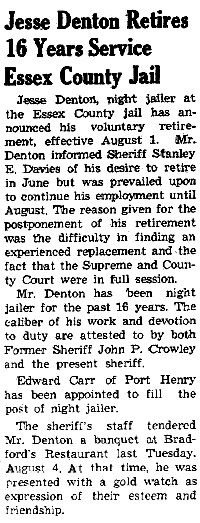 The Aug. 7, 1959 issue of The Essex County Republicancarried a front page story (above) on jailer Jesse Denton's retirement. Denton was the night jailer whose tour duties Earl Torrence took on after completing his own day duties Nov. 15, 1948. Earl took the extra shift so that the night turnkey would get the evening off. Denton's is one of the red underlined names in the 1945 Essex County paroll image further up this web page. The Aug. 7, 1959 issue of The Essex County Republicancarried a front page story (above) on jailer Jesse Denton's retirement. Denton was the night jailer whose tour duties Earl Torrence took on after completing his own day duties Nov. 15, 1948. Earl took the extra shift so that the night turnkey would get the evening off. Denton's is one of the red underlined names in the 1945 Essex County paroll image further up this web page. |
"I knew Earl Torrance well for
many years, both as a constable
and a deputy sheriff and I met
him many times in Bloomingdale
and at E1izabethtown, while he
was on duty in the county Jail.
"He was a kind, good natured,
friendly man; always careful and
conscientious In the performance
of his duties, and both he and
Sheriff John Crowley, sought to
allow the prisoners every right
and every courtesy compatible
with a proper discharge of their
duties. It was a great shock and a
grievious sorrow to read of his
untimely and cruel death.
"Such affairs as this take place
nightly in the gory Western
fllms and on the pages of the
Western Story Pulps, read by
thrill seekers and drug store cow-
boys.
"Seldom however, does such a
sad tale in our own very midst
cause us to listen on the radio or read the local
news to learn the gruesome details. Saranac Lake is not Anzona,
nor yet is it Russia or Germany, where life is said to be
cheap. One of the guardians of
the law has been wiped out and
his death makes sorrow. Right
thinking citizens will pause to
reflect, then to cogitate on what
to do about such circumstances.
"I say nothing about the guilt
of the captured men. The law wfll
take its course and the law is
mightier than the hue and cry of
the multitude or the maudlin sentiment of perverted individuals
that openly say it is cruel and unjust
to call the
attention of our people to the
guardians of the law who captured the criminals after they
were at large.
"For days Captain
Tony Muller and his valiant state
troopers of the State Police, kept
after these men, night and day,
like the Hound of the Baskervilles. Every road, trail, path or
foot bridge was watched by men detailed to
arrest without shooting, a pair of
felons, who had escaped the
County Jai1, and armed or unarmed, were known to be savage
and desperate.
"While you and I went to bed at
night, with or without our back
and front doors locked and watch
dog on the outside, these brave
men were prowling. without sleep
or rest to find and take these desperados. This was not a movie
scenario, nor was it horse piay.
It was real life in the raw.. It was
the stuff in which brave men live.
"Now when it is all over, some
slight token of gratitude is due
the members of Troop B, New York State Police, who worked
and worked together like a good
football team for the capture.
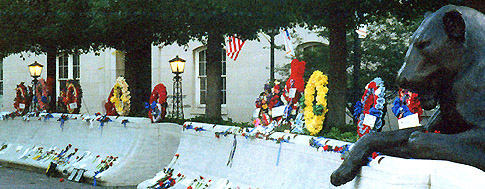 Image above based on a photo taken by CO Joe Stickney at the May 15, 2000, National Peace Officers Day ceremonies adding names to the National Law Enforcement Memorial wall, including his grand uncle Earl Torrence's. Image above based on a photo taken by CO Joe Stickney at the May 15, 2000, National Peace Officers Day ceremonies adding names to the National Law Enforcement Memorial wall, including his grand uncle Earl Torrence's. |
"None of them
will wear any
medals for this job. No man in
the troop will get an embossed
scroll or a citation for his part
in the search and capture. They
will quietly keep on doing their
duty.
"Let us not
forget
that Earl Torrance went to his death
in the silence of the County Jail
at midnight in Elizabethtown
within the shadow
the flag, which should fly at half
mast hereafter for a suitable time
to remind us of just another unsung hero. He was a GUARDIAN
OF THE LAW.
"Francls B. Cantwell
"Saranac Lake
"November 22nd, 1948"
-- NYCHS webmaster
List of Links to Other Pages in New York Correction History Society's
Essex County Jail History Web Presentation
| |
| |
|

